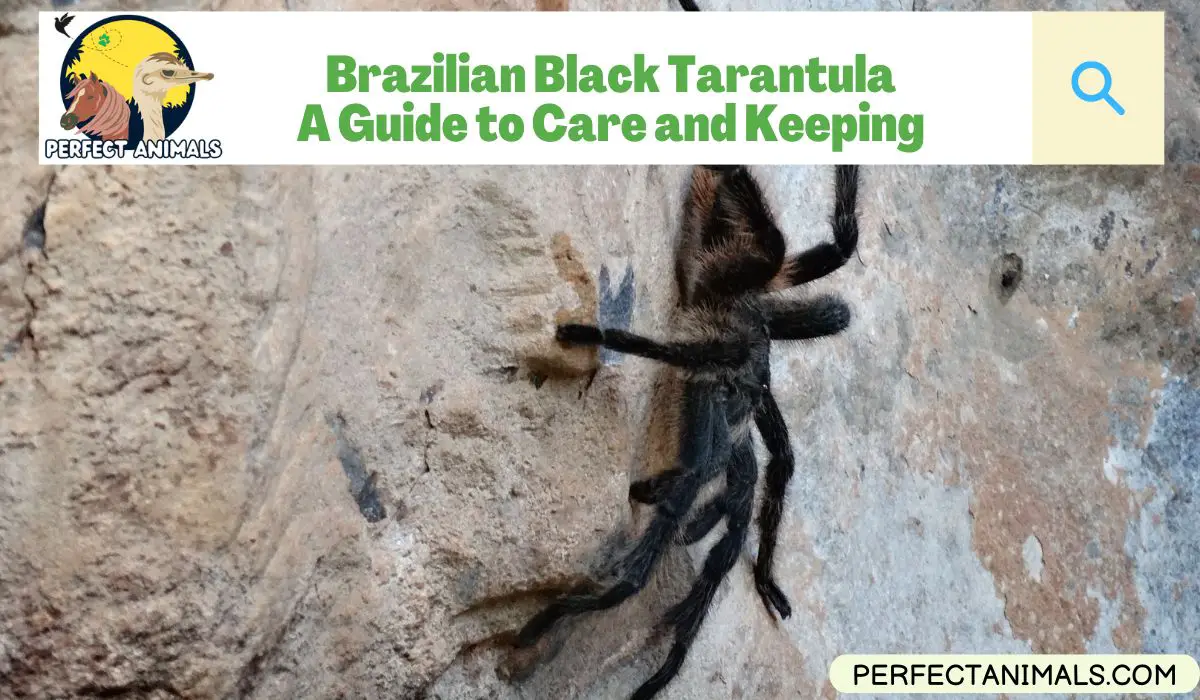THE Brazilian black tarantula, with its striking black coloration and impressive size, has captured the hearts of many arachnophiles and enthusiasts.
Native to the grasslands of Brazil and Uruguay, this species has gained popularity among tarantula keepers due to its docile nature and relatively easy care.
But before diving into the world of Brazilian black tarantulas, it’s essential to understand the basics of these fascinating creatures.
In this article, we’ll explore the key aspects of Brazilian black tarantulas, from their venomous capabilities to their impressive size and lifespan.
Whether you’re a seasoned tarantula enthusiast or just starting your journey, this comprehensive guide will provide you with the information you need to decide if a Brazilian black tarantula is the right pet for you.
| Appearance | Solid black body, making it an appealing tarantula in the pet trade. |
| Native region | Brazil |
| Size | Can reach up to 18 cm (7 in) in length. |
| Growth rate | Slow grower, taking up to eight years to reach maturity. |
| Diet | Feeds on mealworms, crickets, roaches, and other small insects. |
| Pet trade desirability | Desirable due to the long lifespan of females, docile temperament, and reduced tendency to kick urticating hairs. |
How Venomous is a Brazilian Black Tarantula?
The Brazilian black tarantula, like all tarantulas, is venomous. However, it is considered less venomous than other tarantula species.
The venom of the Brazilian black tarantula is primarily used for immobilizing prey, and it is not potent enough to cause significant harm to humans.
Many tarantulas, including the Brazilian black, are more likely to attempt to flee than to bite when threatened.
This is because they have a natural defense mechanism of flicking urticating hairs from their abdomen, which can cause discomfort and irritation to humans but is not typically life-threatening.
It is essential to note that while the venom of the Brazilian black tarantula is not particularly potent, it is still venomous and should be handled cautiously.
Suppose you are considering keeping a Brazilian black tarantula as a pet. In that case, it is crucial to understand the risks involved and take necessary precautions to ensure your safety and the well-being of the spider.
You May Also Like – Animals With Curly Horns
How Big Does a Brazilian Black Tarantula Grow?
The Brazilian black tarantula, known scientifically as Grammostola pulchra, is a large and impressive species.
Females can grow up to 7.5 inches in leg span, while males are slightly smaller, reaching a leg span of around 6.5 inches.

This impressive size, combined with their velvety black hair, makes them a striking addition to any tarantula collection.
The size of a Brazilian black tarantula is one of its most notable features.
They are known for their slow growth rate, taking around 5 to 8 years to reach maturity. This slow growth rate is a characteristic shared by many tarantula species and is a key factor in their popularity among enthusiasts.
In terms of body size, Brazilian black tarantulas can grow up to 6 inches in length, with males being slightly smaller than females.
Their large size and impressive leg span make them a popular choice among tarantula keepers, who appreciate their striking appearance and docile nature.
How Much is a Brazilian Black Tarantula?
The cost of a Brazilian black tarantula can vary depending on several factors, such as the breeder, the spider’s age, and the quality of care.
Generally, Brazilian black tarantulas are considered to be a relatively affordable species, especially compared to some other exotic pets.
On average, a Brazilian black tarantula can cost anywhere from $20 to $50. This price range includes both baby and adult tarantulas.
Baby tarantulas, also known as spiderlings, are typically less expensive, ranging from $10 to $20. Adult tarantulas, on the other hand, can cost more, typically ranging from $30 to $50.
It is essential to note that the cost of a Brazilian black tarantula can vary depending on the breeder and the quality of care.
Some breeders may charge more for their tarantulas due to the level of care and attention they provide.
Additionally, some breeders may offer additional services, such as a starter kit or feeding instructions, which can increase the overall cost.
You May Also Like – Are Hyenas Dogs or Cats?
Are Brazilian Black Tarantulas Good for Beginners?
Brazilian black tarantulas are considered a great choice for beginners due to their docile nature and relatively easy care.
They are known to be calm and tolerant of handling, making them a great option for those new to tarantula keeping.
Additionally, they are relatively slow-growing, which means they don’t require frequent molting or significant changes in their environment.
This stability makes them a great choice for those who want to learn the basics of tarantula care without the added complexity of rapid growth or frequent changes in their pet’s needs.
What Are the Best Enclosures for Housing a Brazilian Black Tarantula?
When it comes to housing a Brazilian black tarantula, it is essential to provide a suitable enclosure that meets their specific needs.
For adults, a 10-15 gallon enclosure with good ventilation and a secure lid is recommended.
The enclosure should be deep enough to allow for burrowing, with a substrate such as peat moss, peat humus, or ground coco fiber.
A hide, such as a piece of cork bark or a small coconut shell, should also be provided to give the tarantula a sense of security.
The enclosure should be well-aired and maintained at a temperature between 75° and 85°F, with a humidity level that is maintained through misting and a water dish.
You May Also Like – Animals With Curly Horns
How Often Should I Feed a Brazilian Black Tarantula?
The frequency of feeding a Brazilian black tarantula depends on its age and size. Spiderlings require more frequent feeding, typically every other day, while adults can be fed less frequently.
For adults, a diet of crickets, mealworms, and roaches is recommended, with prey items provided 3-8 times a month depending on their size.
It is essential to ensure that the prey items are not larger than the tarantula’s body size and that the tarantula is eating well before increasing the frequency of feeding.
How Long Does a Brazilian Black Tarantula Live?
The lifespan of a Brazilian black tarantula can vary significantly depending on several factors, including sex, environment, and care.
On average, males have a shorter lifespan, ranging from 5 to 6 years, while females can live for 20 years or more.
There are documented cases of female Brazilian black tarantulas reaching the age of 30 years old.
This remarkable longevity is one of the reasons they are a popular choice among tarantula enthusiasts.
Will Brazilian Black Tarantulas Burrow Themselves?
Yes, Brazilian black tarantulas are known to burrow themselves.
They either dig their own burrows or move into abandoned holes from other animals. These burrows are their primary residence, where they spend most of their lives.
They are nocturnal animals and leave their burrows at night to hunt for prey, which they catch by waiting at the entrance of their burrows and snatching unsuspecting insects that pass by.
Final Thoughts
As you’ve learned about the Brazilian black tarantula, I hope you’ve been inspired by their unique charm and fascinating nature.
With their gentle demeanor and impressive size, they can make a wonderful pet for anyone interested in tarantula keeping.
Remember to provide them with the right environment and care, and you’ll be rewarded with a lifelong companion that will captivate and delight you.

Brittney , a devoted exotic pet enthusiast, showcases her profound passion for the animals through her role as a veterinary technician. With a strong background in caring for a diverse array of animals, she shares her expertise by crafting engaging articles about exotic pets for our blog.

